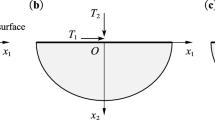Abstract
This paper investigates interfacial cracks with arbitrary crack surface tractions. A novel singular finite element which is constructed with the analytical solution around interfacial cracks is presented. Interfacial crack problems can be analyzed numerically using the singular finite element, and Mode I and/or Mode II stress intensity factors can be obtained directly. Unlike other enriched elements for cracks, neither extra unknowns nor transition elements are required. Numerical examples are given to illustrate the validity of present method.
Similar content being viewed by others
References
ANSYS Release 11.0: (2007) Documentation for ANSYS. ANSYS Inc., PA
Barsoum RP (1984) Triangular quarter-point elements as elastic and perfectly-plastic crack tip elements. Int J Numer Methods Eng 11: 185–198
Benzley SE (1974) Representation of singularities with isoparametric finite elements. Int J Numer Methods Eng 8: 537–545
Belytschko T, Lu YY, G L (1994) Element-free Galerkin methods. Int J Numer Methods Eng 37: 229–256
Dugdale DS (1960) Yielding of steel sheet containing slits. J Mech Phys Solids 8: 100–108
Fleming M, Chu YA, Moran B, Belytschko T (1997) Enriched element-free Galerkin methods for crack tip fields. Int J Numer Methods Eng 40: 1438–1504
Franca LP, Ramalho JVA, Valentin F (2006) Enriched finite element methods for unsteady reaction–diffusion problems. Commun Numer Methods Eng 22: 619–625
Fries TP, Belytschko T (2010) The extended/generalized finite element method: an overview of the method and its applications. Int J Numer Methods Eng 84: 253–304
Hatamleh O, Forman R, Shivakumar V, Lyons J (2005) Strip yield model numerical application to different geometries and loading conditions. Int J Fract 134: 251–265
Henshell RD, Shaw KG (1978) Crack tip finite elements are unnecessary. Int J Numer Methods Eng 9: 495–507
Hu XF, Yao WA, Fang ZX (2011) Stress singularity analysis of anisotropic multi-material wedges under antiplane shear deformation using the symplectic approach. Theor Appl Mech Lett 1: 061003
Ikeda T, Nagai M, Yamanaga K, Miyazaki N (2006) Stress intensity factor analyses of interface cracks between dissimilar anisotropic materials using the finite element method. Eng Fract Mech 73: 2067–2079
Li J, Zhang XB, Recho N (2001) Stress singularity near the tip of a two-dimensional formed from several elastic anisotropic materials. Int J Fract 107: 379–395
Liu GR, Gu YT (2001) A local radial point interpolation method (LR-PIM) for free vibration analysis of 2-D solids. J Sounds Vib 246: 29–46
Liew KM, Cheng Y, Kitipornchai S (2007) Analyzing the 2D fracture problems via the enriched boundary element-free method. Int J Solids Struct 44: 4220–4233
Lim CW, Cui S, Yao WA (2007) On new symplectic elasticity approach for exact bending solutions of rectangular thin plates with two opposite sides simply supported. Solids Struct 44: 5396–5411
Lim CW, Yao WA, Cui S (2008) Benchmark symplectic solutions for bending of corner-supported rectangular thin plates. IES J Part A Civ Struct Eng 1: 106–115
Lim CW, Xu XS (2010) Symplectic elasticity: theory and applications. Appl Mech Rev 63(050802): 1–10
Miyazaki N, Ikeda T, Soda T, Munakata T (1993) Stress intensity factor analysis of interface crack using boundary elemental method-application of contour-integral method. Eng Fract Mech 45: 599–610
Moes N, Belytschko T (2002) Extended finite element method for cohesive crack growth. Eng Fract Mech 69: 813–833
Murakami Y (1987) Stress intensity factors handbook. Pergamon Press, New York
Nguyen V, Rabczuk T, Bordas S, Duflot M (2008) Meshless methods: a review and computer implementation aspects. Math Comput Simul 79: 763–813
Rice JR, Sih GC (1965) Plane problems of cracks in dissimilar media. J Appl Mech 32: 418–423
Williams ML (1959) The stress around a fault or crack in dissimilar media. Bull Seismol Soc Am 49: 199–208
Yao WA, Zhong WX, Lim CW (2009) Symplectic elasticity. World Scientific, Singapore
Zhang HW, Zhong WX (2003) Hamiltonian principle based stress singularity analysis near crack corners of multi-material junctions. Int J Solid Struct 40: 493–510
Zhong WX (1995) A new systematic methodology for theory of elasticity. Dalian University of Technology Press, Dalian (in Chinese)
Zhou ZH, Xu XS, Leung AYT (2009) The mode III stress/electric intensity factors and singularities analysis for edge-cracked circular piezoelectric shafts. Int J Solids Struct 46: 3577–3586
Author information
Authors and Affiliations
Corresponding author
Rights and permissions
About this article
Cite this article
Hu, X.F., Yao, W.A. A novel singular finite element on mixed-mode bimaterial interfacial cracks with arbitrary crack surface tractions. Int J Fract 172, 41–52 (2011). https://doi.org/10.1007/s10704-011-9645-3
Received:
Accepted:
Published:
Issue Date:
DOI: https://doi.org/10.1007/s10704-011-9645-3




